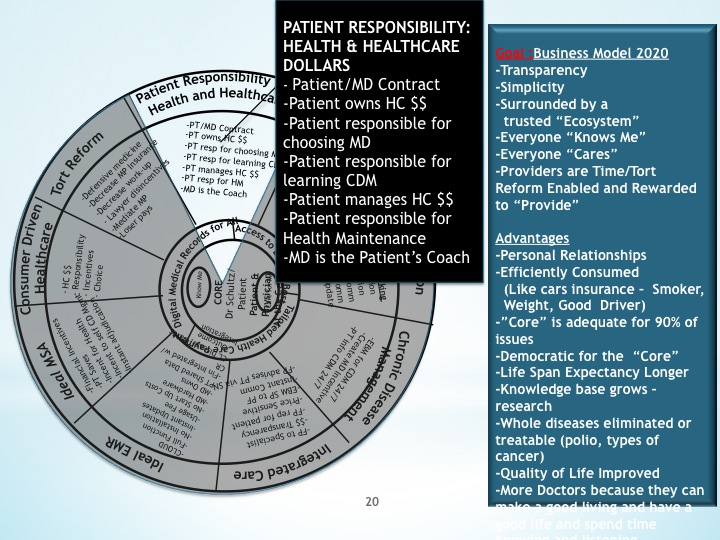Pay For Performance (P4P) Pilot Project Fails
Stanley Feld M.D.,FACP,MACE
The CBO announced that the P4P pilot project did not reduce the cost of providing healthcare nor yielded long-term gains in mortality.
"Tying financial incentives to performance, often referred to as pay for performance, has gained broad acceptance as an approach to improving the quality of health care.1-4
The Centers for Medicare and Medicaid Services (CMS) recently completed a 6-year demonstration of pay for performance for hospitals through the Premier Hospital Quality Incentive Demonstration (HQID), and the Affordable Care Act calls for CMS to expand this program to nearly all U.S. hospitals in 2012.
P4P sounds good theoretically. The government paying more money for better outcomes sounds logical from the payer’s point of view. It is not logical from the payees’ (physicians’) point of view.
The emphasis of P4P is on physicians and hospitals practice process to improve quality through the use of evidence based medicine.
The evidence based medicine guidelines are determined by the Independent Physician Advisory Board (IPAB). The evidence based medicine should improve quality and lead to better patient outcomes and decrease healthcare costs..
This pilot project showed that P4P does not produce the desired result. The hope was to inspire poor performing centers to improve and good performing centers to perform better in order to receive incentive pay for performance as a bonus.
"In summary, we found little evidence that participation in the Premier HQID program led to lower 30-day mortality rates, suggesting that we still have not identified the right mix of incentives and targets to ensure that pay for performance will drive improvements in patient outcomes.
Even though Congress has required that the CMS adopt pay for performance for hospitals, expectations with regard to programs modeled after Premier HQID should remain modest."
This last sentence is great advice.
Congress and President Obama should reexamine their premise.
Patients’ performance is left out of the P4P program. Patients’ attitude toward their disease, adherence to taking medicine prescribed, compliance with prescribed therapy and patients ability to make rapid therapeutic adjustment of medications depends on patients and not physicians or physicians’ practice process.
There is no question that the process of care is important. There is no question that processes based on evidence must be learned by all physicians. There is also no question that processes based on evidence rapidly change and must be swiftly adjusted.
The most important determinant in patients’ outcome depends on patients. Physicians’ practices should not be judged disregarding patients’ behavior.
It is the physicians’ responsibility to teach patients how to be “Professors Of Their Diseases.”
Just imagine how many re-hospitalizations could be avoided for congestive heart failure if patients were motivated and educated to detect the onset of congestive heart failure and how to increase the dosage of medication to abort the episode.
Think of all the heart disease that could be prevented if obesity was prevented.
Think of all the acute asthma attacks and uncontrolled diabetes whose hospitalizations could be prevented.
Think about all the complications of diseases could be prevented if patients were incentivized to lead a healthy lifestyle.
At present the administration is trying to change incentives. It will not work.
The reason is simple.
I have written several blogs on why P4P will fail.
When will someone listen?
I clearly explained the reasons for predicting P4P’s failure in a blog written in April 2007.
Pay for Performance(P4P): Another Complicated Mistake.
April 15,2007
Stanley Feld M.D.FACP,MACE
The intuitive meaning of Pay for Performance (P4P) is the better you perform the more you get paid. This is true in many industries. The concept is well advertised in the well publicized salaries of professional athletes. Recently we have heard of grotesques salaries of fired CEO that get hundreds of millions of dollars in termination salaries for doing a bad job. They are getting paid well for poor job performance.
The underlying assumption is that with P4P, physicians should be responsible and accountable for medical outcomes. The physicians will be reimbursed for medical outcomes. The reimbursements made to the physicians are under the control of the government or insurance industry. These entities are interpreting the criteria for the quality of medical outcomes.
We have seen what happened to Dr. Petak even though his treatment is correct and saves money for the health care system. Many physicians feel P4P is simply code for reducing physician reimbursement. In an environment of existing mistrust between all the stakeholders, the potential is great for generating more mistrust. The growth of the mistrust will result in more dysfunction in the healthcare system and increased cost.
The definition of quality medical care has not been made clear by the secondary facilitators while proposing the P4P rollout. Organized medicine has not been outraged by the proposal. No one has analyzed it with all the potential for unforeseen consequence. Can P4P prevent the onset of disease or decrease complication rate for chronic disease? Who are the responsible stakeholders for increasing quality? The stakeholders responsible for medical quality care are the physician and the patient. If the patients do not adhere to the medical regime prescribed, the quality of care will not improve. Many studies have shown that compliance rates are as low as 30% for certain treatments. Patients will not have improved medical outcomes if they do not follow a treatment plan. Why should the physician be penalized? Why doesn’t the government and the insurance industry declare that patients are equally responsible for both good and bad medical outcomes? The structures of bureaucratic systems would not permit it because not only would it be judged to be insensitive it would be socially incorrect and result in a public outrage.
Patients have to be educated and become professor of their disease, be responsible for their health behaviors such as filling their prescriptions, exercising , decreasing obesity, not smoking or drinking. All preventive measures must be promoted. Patient need to be responsible their behavior and adherence to therapy. The physicians should not experience all of the brunt of poor outcomes or the credit for good outcomes. The P4P movement is misguided.
They are misguided when they think this is the fix. P4P represents another false hope and complicated mistake that in my opinion will lead to great cost to the healthcare system without improvement in medical outcomes.
I have defined quality medical care in a measurable way. None of these criteria are individual indicators of quality medical care. The system of quality of care should be the quality measure of prevention of medical complications and not the measurement of the parts on the path toward quality medical care. The patients’ activity is at least half of the quality equation to reduce the complications of chronic disease.
However, the secondary stakeholders are making a mistake with P4P. They have developed artificial quality indicators that do not measure quality medical care accurately. They want to force physicians to follow their indicators rather than use their medical skill and medical judgment. The way to improve quality is not to be punitive to the physicians. They are only one half of the quality equation to reduce medical care cost. The way to do it is to set up a competitive environment.
Lasik surgery is a perfect example. It stated with all ophthalmologic doing Lasik for $3000 an eye. Insurance did not pay for Lasik surgery. Some ophthalmologists’ developed focus factories that did just Lasik surgery. They developed economies of scale and expertise that enabled them to reduce the price. Patients chose these focused factories on the bases of price, and outcomes rather than the local opthalmologists. The price in some cities is now $250 an eye. Remember patients are not stupid. However, they are the 50% of the quality care equation. They will spend their money wisely and drive quality, if they own their healthcare dollar. It is our job to teach patients how to make the correct decisions. It is not the insurance industry or the government to restrict access to care and judge what is best. I believe the market place can do it.
In diabetes the healthcare system sends 15% of the healthcare dollar on 5% of the population and rising. Ninety percent of those dollars is spent on the complications of diabetes. If patients with diabetes were given control of their healthcare dollar and were rewarded for avoiding complications of diabetes we would be on our way to a competitive environment for the treatment of diabetes. The patients would search for physicians that had economies of scale and expertise to help them improve their quality of medical care. They would drive the creation of focus factories in diabetes as well as any other chronic disease. The system would then be stimulating competition and improving quality medical care not punishing physicians and patients. A negative and faulty penalty system (P4P) will not solve any of our problems. I predict it will only make it worse for the patient and the physician and more profitable for the insurance industry and hospitals. The physician and patient community ought to be outraged. They are not because we are a sound byte society and do not pay attention to the details of issues.
The P4P fad is simply another reason why patients need to be in control of their healthcare dollar. They should be rewarded if they avoid complications and improve their health. Physicians should compete to develop focus factories in order to generate economies of scale and improved medical outcomes. All of this has to be done in a price transparent environment.
April 15, 2007 in Medicine: Healthcare System | Permalink
The opinions expressed in the blog “Repairing The Healthcare System” are, mine and mine alone.
If you like this blog please send it to a friend



